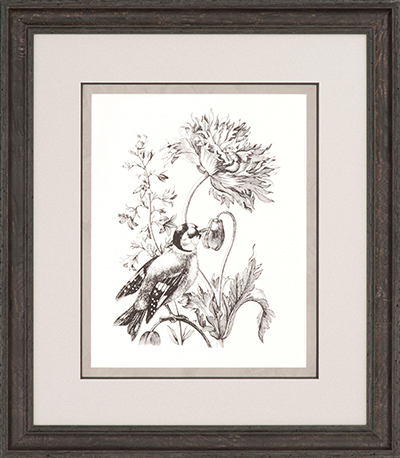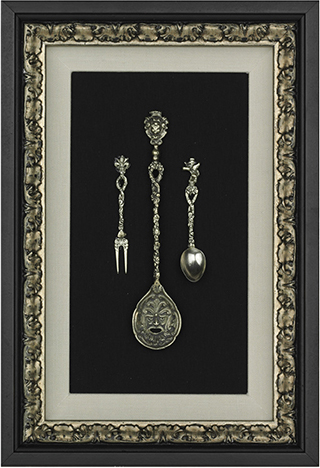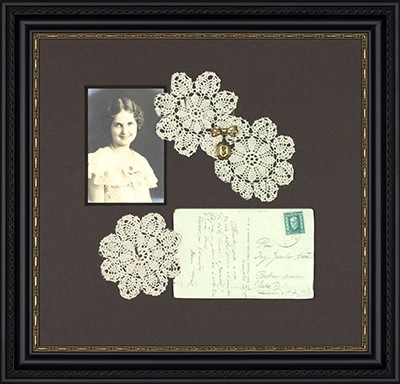“Our approach ensures that the materials and design used
will enhance the beauty of the work, as well as, protect
and preserve the integrity and value of the art.”
What is conservation framing?
Conservation framing is the process of designing and custom framing using archival materials and museum-standard techniques to preserve and ultimately extend the life of the artwork.
At Georgian Bay Art Conservation we design with intent and craft with skill in an effort to develop unique frame and storage solutions for our clients. What sets us apart from other custom framing studios is the opportunity to consult directly with our in-house conservators while working one-on-one with our custom-framing specialists.
Our process involves assessing each work individually in order to determine the most appropriate type of housing required, based upon the medium, the stability of the piece, the style, and the client’s display requirements. Our approach ensures that the materials and design used will enhance the beauty of the work, as well as, protect and preserve the integrity and value of the art.

“The manner in which
a work of art is
mounted and framed
will have tremendous
effect on both its
long-term preservation
and the way in which
the art is perceived.”
Common Risk Factors
Our conservators have seen first hand the damaging effects improper mounting techniques and poor quality framing materials can have on works of art. To ensure the safety and long-term preservation of your collection or irreplaceable family heirloom we recommend having old framing materials updated and the work examined by our conservators while it is unframed.
Some of the most common types of damage we treat in our conservation studio are caused by:
- Artwork coming into direct contact with non-archival adhesives such as masking and scotch tapes, and synthetic or protein based glues.
- The use of poor quality window mats (most materials used prior to the 1980s will not be archival), and backer boards such as cardboard or acidic foam core; causing artwork to become brittle, stained (foxing), and severely discolored (mat-burn).
- Improper hinging and mounting techniques; causing artwork to slip, tear, distort, or even split in half.
- Non-UV filtering glazing; causing the artwork to fade and yellow over time.
- Artwork framed without adequate space between it and the glass; causing the artwork to stick to the glazing when exposed to heat or moisture.
- Physical damage to artwork and decorative frames caused by the use of inadequate hardware and installation techniques.
Elements of Conservation Framing
Hinging & Mounting: The artwork should be hinged to an archival support board with acid-free hinges such as Japanese paper and wheat starch paste. The quality and quantity must be sufficient to adequately support the weight of the artwork. Any mounting or hinging method employed should be reversible and not cause planar distortions or discoloration of the artwork over time.
Matting: The best and proven choice in conservation framing is 100% acid-free cotton rag board.
Backing Boards: All backing boards used should be acid-free and archival as well as stable and rigid. Artwork should never be mounted directly to the backing board.
Glazing: UV filtering glass or acrylic is essential in conservation. We offer a range of Tru-Vue conservation grade products, including: conservation clear, reflection control, and museum glass or acrylic. Artwork should never be framed in direct contact with the glazing material.
Protect your investment and memories…
with expert conservation framing!

Archival Storage & Enclosures
Once suitably housed, the piece should be stored or displayed appropriately and carefully. Proper storage solutions, not just for transporting artwork but also for those works that are not currently displayed, are an integral part of maintaining any collection. Through consultation with our preservation specialists a customized storage plan can be developed to address the specific requirements of your unique collection. Our technicians are skilled at crafting one-of-a-kind storage and display solutions for even the most unique of objects. With the right precautions taken and regular monitoring, a collection can be safely maintained and displayed for future generations to enjoy. For more detailed information on collection care and maintenance please view our Collections Management service page.
“An ounce of prevention is worth a pound of cure.”



Arced Frames & Convex Glass

If you can imagine it…
we can frame it!
- Fine art – paintings, works of art on paper, photography
- Archival documents
- Family heirlooms & memorabilia
- Children’s artwork
- 3D objects
- Family photographs
- Military honours & awards
- Diplomas

















